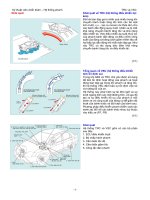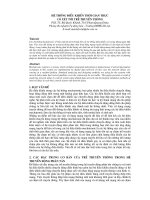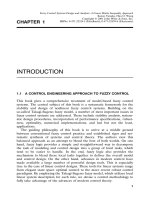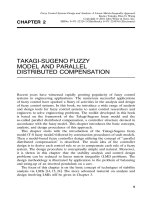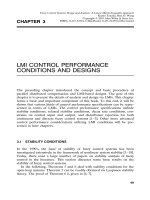Tài liệu Hệ thống điều khiển mờ - Thiết kế và phân tích P15 doc
Bạn đang xem bản rút gọn của tài liệu. Xem và tải ngay bản đầy đủ của tài liệu tại đây (155.04 KB, 12 trang )
Fuzzy Control Systems Design and Analysis: A Linear Matrix Inequality Approach
Kazuo Tanaka, Hua O. Wang
Copyright ᮊ 2001 John Wiley & Sons, Inc.
Ž. Ž .
ISBNs: 0-471-32324-1 Hardback ; 0-471-22459-6 Electronic
CHAPTER 15
FUZZY CONTROL OF NONLINEAR
TIME-DELAY SYSTEMS
In this chapter, a class of nonlinear time-delay systems based on the Takagi-
Ž. wx
Sugeno T-S fuzzy model is defined 1 . We investigate the delay-indepen-
dent stability of this model. A model-based fuzzy stabilization design utilizing
Ž.
the concept of parallel distributed compensation PDC is employed. The
main idea of the controller design is to derive each control rule to compen-
sate each rule of a fuzzy system. Moreover, the problem of H control of this
ϱ
class of nonlinear time-delay systems is considered. The associated control
Ž.
synthesis problems are formulated as linear matrix inequality LMI prob-
lems.
In the original T-S fuzzy model formulation, there is no delay in the
control and state. However, time delays often occur in many dynamical
systems such as biological systems, chemical systems, metallurgical processing
systems, and network systems. Their existence is frequently a cause of
instability and poor performance. The study of stability and stabilization for
wx
linear time-delay systems has received considerable attention 2᎐ 6.But these
efforts were mainly restricted to linear time-delay systems. Thus, it is impor-
tant to extend the stability and stabilization issues to nonlinear time-delay
systems. In this chapter, a particular class of nonlinear time-delay systems is
introduced based on the Tagaki-Sugeno fuzzy model. This kind of nonlinear
system is represented by a set of linear time-delay systems. We will call this a
Ž.
T-S model with time delays T-SMTD . In the literature, the problem of
stability and stabilization of time-delay systems has been dealt with a number
of different ways. There are some results that are independent of the size of
wx
the time delays in 2᎐ 4,and the stability is satisfied for any value of the time
delays. There are also some delay-dependent results, in which the stability is
291
FUZZY CONTROL OF NONLINEAR TIME-DELAY SYSTEMS
292
wx
guaranteed up to some maximum value for the time delays 5, 6 . This
chapter is concerned with the problems of delay-independent stability and
stabilization of T-S fuzzy models with time delays. Particularly, we will
employ the concept of parallel distributed compensation to study these
problems. Several new results concerned with the stability and stabilization of
T-SMTD are derived. Also, a sufficient condition for the H control of this
ϱ
model is given. All the synthesis problems are formulated as LMIs, thus they
are numerically efficient.
Throughout the chapter, the notation M ) 0 will mean that M is a
positive definite symmetric matrix. The symbol p will be used for premise
variables as in Chapters 12 and 13.
15.1 T-S FUZZY MODEL WITH DELAYS AND STABILITY
CONDITIONS
15.1.1 T-S Fuzzy Model with Delays
To begin with, we represent a given nonlinear plant by the Takagi-Sugeno
fuzzy model. Then, we will define a new kind of model, the Takagi-Sugeno
fuzzy model with time delays. The main feature of the T-S fuzzy model is to
Ž.
express the joint dynamics of each fuzzy implication rule by a linear system
model. Specifically, the Takagi-Sugeno fuzzy system is described by fuzzy
IF-THEN rules, which locally represent linear input-output relations of a
system. The fuzzy system is of the following form:
Dynamic Part: Rule i
Ž. Ž.
IF ptis M , ,and ptis M ,
1 i1 lil
THEN
xt s Ax t q Bu t , i s 1,2, ,r.15.1
Ž. Ž. Ž. Ž .
˙
ii
Output Part: Rule i
Ž. Ž.
IF ptis M , ,and ptis M ,
1 i1 lil
THEN
yt s Cx t .
Ž. Ž.
i
Ž. Ž. Ž. Ž.
Here, xt, ut, yt, and pt respectively denote the state, input, output,
Ž. Ž.
and parameter vectors. The jth component of pt is denoted by pt, and
j
T-S FUZZY MODEL WITH DELAYS AND STABILITY CONDITIONS
293
the fuzzy membership function associated with the ith rule and jth parame-
Ž.
ter component is denoted by M . Each pt is a measurable time-varying
ij j
quantity. In general, these parameters may be functions of the state variables,
external disturbances, andror time.
Ž.
There are two functions of pt associated with each rule. The first
function is called the truth value. The truth value for the ith rule is defined
by the equation
l
pt s Mpt.
Ž. Ž.
Ž.
Ž.
Ł
iijj
j
s1
Throughout this chapter, we will assume that each
is a nonnegative
i
function and that the truth value of at least one rule is always nonzero. The
second function is called the firing probability. The firing probability for the
ith rule is defined by the equation
pt
Ž.
Ž.
i
hpt s ,
Ž.
Ž.
i
r
Ý
pt
Ž.
Ž.
is1 i
where r denotes the number of rules in the rule base. Under the previously
stated assumptions, this is always a well-defined function taking values
between 0 and 1, and the sum of all the firing probabilities is identically
equal to 1.
Now, we introduce time delays into the above T-S fuzzy model. Here, we
assume there are time delays in both the state and control of the dynamic
part. Then, the i rule of the dynamic part of T-S fuzzy model becomes:
Rule i
Ž. Ž.
IF ptis M , , and ptis M
1 i1 lil
THEN
xt s Axtq Axty
q Butq Buty
,
Ž. Ž. Ž . Ž. Ž .
˙
i0 id 1 i0 id 2
i s 1,2, ,r ,15.2
Ž.
where 0 F
- ϱ and 0 F
- ϱ are the size of the time delays. The initial
12
Ž.
condition is xt s 0, where t - 0.
Ž.
We call this model the T-S model with time delays T-SMTD . In the
following we will investigate the stability and design issues, such as delay-
independent stabilization and H control, of this system.
ϱ
FUZZY CONTROL OF NONLINEAR TIME-DELAY SYSTEMS
294
The dynamics described by the T-SMTD evolve according to the system of
equations
r
xt s hpAxtq Axty
Ä
Ž. Ž . Ž. Ž .
˙
Ý
ii0 id 1
i
s1
qBut q Buty
,15.3
4
Ž. Ž . Ž .
i0 id 2
r
yt s hpCxt.
Ž. Ž . Ž.
Ý
ii
i
s1
The open-loop system is of the form
r
xt s hpAxtq Axty
.15.4
Ä4
Ž. Ž . Ž. Ž . Ž .
˙
Ý
ii0 id 1
i
s1
Remark 45 Our proposed model description can also be viewed as parame-
ter-dependent interpolation between linear models; however, the exact classi-
fication of the resultant system depends on the nature of the parameters. For
example, if each p is a known function of time, then the T-S model describes
i
a linear time-varying system. If, on the other hand, each p is a function of
i
the state variables, then the T-S model describes an autonomous nonlinear
system.
15.1.2 Stability Analysis via Lyapunov Approach
A sufficient delay-independent stability condition for the open-loop system
Ž.
15.4 is given as follows:
Ž.
THEOREM 58 The open-loop T-S fuzzy system with time delays 15.4 is
globally asymptotically stable if there exist two common positi®e definite matrices
P and R such that
PA q A
T
P q PA R
y1
A
T
P q R - 0, i s 1,2, ,r ,15.5
Ž.
i0 i0 id id
that is, two common matrices P and R ha®e to exist for all subsystems.
Ž.
Proof. For the open-loop system 15.4 , we define a Lyapunov function as the
following:
t
TT
Vxs x t Px t q x s Rx s ds.15.6
Ž . Ž. Ž. Ž. Ž. Ž .
H
t
y
1
T-S FUZZY MODEL WITH DELAYS AND STABILITY CONDITIONS
295
Ž. Ž .
The derivate of Vx along the open-loop system 15.4 is
r
T
T
˙
Vxs hpxt PAq APxt
Ž . Ž . Ž. Ž.
Ý
ii0 i0
i
s1
r
T
q 2 h pxt PA xty
Ž.Ž. Ž .
Ý
iid1
i
s1
TT
q x t Rx t y xty
Rx t y
.15.7
Ž. Ž. Ž . Ž . Ž .
11
Using the fact that
TT
y1 T
2 xt PA xty
F x t PA R A Px t
Ž. Ž . Ž. Ž.
id 1 id id
T
q xty
Rx t y
,15.8
Ž.Ž. Ž.
11
we have
r
T
˙
VxF hpxt
Ž. Ž .Ž.
Ý
i
i
s1
= PA q A
T
P q PA R
y1
A
T
P q Rxt-0, ᭙ x/0. 15.9
Ž. Ž .
Ä4
i0 i0 id id
Ž.
Q.E.D.
Ž.
Remark 46 The system 15.4 is also said to be quadratically stable and the
Ž.
function Vx is called a quadratic Lyapunov function. Theorem 58 thus
presents a sufficient condition for quadratic stability of the open-loop system
Ž.
15.4 .
15.1.3 Parallel Distributed Compensation Control
wx
In 7 , Wang et al. utilized the concept of parallel distributed compensation
Ž. Ž.
PDC to design fuzzy controllers to stabilize fuzzy system 15.1 . The idea is
to design a compensator for each rule of the fuzzy model. The resulting
overall fuzzy controller, which is nonlinear in general, is a fuzzy blending of
each individual linear controller. The fuzzy controller shares the same fuzzy
Ž.
sets with the fuzzy system 15.1 . Here, we will apply the same controller
structure to the T-SMTD, so the ith control rule is as follows:
Control Rule i
Ž. Ž.
IF ptis M and, . . . , and ptis M ,
1 i1 lil
Ž. Ž.
THEN ut syFxt, i s 1, ,r.
i
FUZZY CONTROL OF NONLINEAR TIME-DELAY SYSTEMS
296
The output of the PDC controller is determined by the summation
r
ut sy hpFxt. 15.10
Ž. Ž . Ž. Ž .
Ý
ii
i
s1
Ž.
Note that the controller 15.10 is nonlinear in general.
Ž. Ž.
The Closed-Loop System Substituting 15.10 into 15.3 , we obtain the
corresponding closed-loop system
r
2
Ä4
Ž. Ž . Ž.
Ž. Ž.
xt s hpGxtq Axty
y BFxty
˙
Ý
iii id
1 id i 2
is1
r
Ž. Ž.
G q GAxty
q Axty
ij ji id
1 jd 1
Ž. Ž. Ž.
q 2 hphp xtq
ÝÝ
ij
½
22
is1 i-j
Ž. Ž.
yBFxty
y BFxty
id j
2 jd i 2
q ,
5
2
15.11
Ž.
where G s A y BF.
ij i0 i0 j
15.2 STABILITY OF THE CLOSED-LOOP SYSTEMS
Now, we present a delay-independent stability condition for the closed-loop
Ž.
system 15.11 .
THEOREM 59 If there exist matrices P ) 0, R ) 0, and R ) 0 such that
12
Ž.
the following matrix inequalities are satisfied, the closed-loop system 15.11 is
quadratically stable:
PG q G
T
P q PA R
y1
A
T
P q R q PB F P
y1
R
y1
P
y1
F
T
B
T
P q PR P - 0,
ii ii id 1 id 1 id i 2 iid 2
i s 1, ,r , 15.12
Ž.
T
G q GGq G 1
ij ji ij ji
y1 T y1 T
P q P q PAR A q AR A P
Ž.
id 1 id jd 1 jd
ž/ž/
222
1
y1 y1 y1 TT
q R q PBFP R P FB
Ž
1 id j 2 jid
2
qBFP
y1
R
y1
P
y1
F
T
B
T
q PR P F 0. 15.13
Ž.
.
jd i 2 ijd 2
STATE FEEDBACK STABILIZATION DESIGN VIA LMIs
297
Proof. Define the following Lyapunov function for the closed-loop system:
t
TT
Vxs x t Px t q xs Rxs ds
Ž . Ž. Ž. Ž. Ž.
H
1
t
y
1
t
T
q x s PR Px s ds. 15.14
Ž. Ž. Ž .
H
2
t
y
2
Ž.
Taking the derivative of Vx along the closed-loop system and using the
fact that for any vector x and x and matrix Y
12
x
T
Yx q x
T
Y
T
x F x
T
YR
y1
Y
T
x q x
T
Rx , 15.15
Ž.
12 2 1 1 1 22
where R is a positive definite matrix, we have
r
T
2 T y1 T
˙
Vxs hpxt PGq GPq PA R A P q R
Ž. Ž.Ž.
Ä
Ý
iiiiiid1 id 1
i
s1
qPB F P
y1
R
y1
P
y1
F
T
B
T
P q PR P x t
Ž.
4
id i 2 iid 2
T
r
G q GGq G
ij ji ij ji
T
q 2 hhx t P q P
Ž.
ÝÝ
ij
½
ž/ž/
22
i
s1 i-j
1
y1 T y1 T
q PAR Aq AR A Pq R
Ž.
id 1 id jd 1 jd 1
2
1
y1 y1 y1 TT
q BFPRPFB
Ž
id j 2 jid
2
qBFP
y1
R
y1
P
y1
F
T
B
T
q PR P x t .
Ž.
.
jd i 2 ijd 2
5
15.16
Ž.
Since Ý
r
h ) 0 and h G 0, we have
is1 ii
˙
Vx- 0, ᭙ x / 0. 15.17
Ž. Ž .
Ž.
Q.E.D.
15.3 STATE FEEDBACK STABILIZATION DESIGN VIA LMIs
The state feedback stabilization design problem can be stated as follows:
Given a plant described by a T-SMTD model, find a PDC control that
quadratically stabilizes the closed-loop system. The design variables in this
Ž.
problem are the gain matrices F 1 F i F r . The following theorem states
i
FUZZY CONTROL OF NONLINEAR TIME-DELAY SYSTEMS
298
conditions that are sufficient for the existence of such a PDC controller.
Taken together, these conditions form an LMI feasibility problem. If this
problem is analyzed numerically and a feasible solution is found, then a set of
stabilizing gain matrices can be computed directly from the solution data.
THEOREM 60 A sufficient condition for the existence of a PDC controller
Ž.
that quadratically stabilizes the T-SMTD model 15.3 is that there exist matrices
X ) 0, W ) 0, W ) 0, and M ,1F i F r, such that the following two LMI
12 i
conditions hold:
Ž.
a For e®ery 1 F i F r, the following equation is satisfied:
TT
AXq XA q AWA
i0 i0 id 1 id
XBM
id i
TT
ž/
yBMy MB q W
i0 iii02
- 0. 15.18
Ž.
X yW 0
1
TT
MB 0 yW
iid 2
Ž.
b For e®ery pair of indices satisfying 1 F i F j F r, the equation
U q V q W X BM BM
ij ij ij id j jd i
1
X y W 00
1
2
F 0 15.19
Ž.
TT
MB 0 yW 0
jid 2
TT
MB 00yW
ijd 2
holds, where
U s AXq XA
T
q AXq XA
T
,
ij i0 i0 j0 j0
V syBMy M
T
B y BMy M
T
B ,
ij i0 jji0 j0 iij0
W s AWA
T
q AWA
T
q 2W .
ij id 1 id jd 1 jd 2
Furthermore, if the matrices exist which satisfy these inequalities, then the
feedback gains F s MX
y1
will pro®ide a quadratically stabilizing PDC
ii
controller.
Proof. Let P s X
y1
, W s R
y1
, and W s R . Then we can get the above
11 22
Ž.
results following Theorem 59. Q.E.D.
H
CONTROL
ϱ
299
15.4 H CONTROL
ϱ
In this section, we will investigate the problem of disturbance rejection for
the T-S fuzzy model with time delays. We assume the ith rule of the model is
Ž. Ž.
IF ptis M and, . . . , and ptis M ,
1 i1 lil
THEN
xt s Axtq Axty
q But q Buty
q Dw t ,
Ž. Ž. Ž . Ž. Ž . Ž.
˙
i0 id 1 i0 id 2 i
i s 1,2, ,r , 15.20
Ž.
zt s Ex t ,
Ž. Ž.
i
Ž. Ž.
where wt is the square integrable disturbance input vector and zt is the
controlled output.
Ž.
Our objective here is to construct an H controller in the form 15.10 such
ϱ
Ž.
that a the controller is a stabilizer for the nonlinear time-delay system and
Ž.
b subject to assumption of zero initial condition, the controlled output z
ϱ
5 Ž.5
2
2
w
ϱ
5 Ž.5
2
xwx
satisfies H zt F
␥
H wt dt for all w g L 0 ϱ , where
␥
is a pre-
00 2
specified positive constant. If this kind of controller exists, the nonlinear
Ž.
time-delay system 15.20 is said to be stabilizable with an H -norm bound
␥
.
ϱ
Ž.
THEOREM 61 For the system 15.20 , a sufficient condition for the existence
of a PDC controller that stabilizes the T-SMTD model with an H -norm bound
␥
ϱ
is that there exist matrices X ) 0, W ) 0, W ) 0, and M ,1F i F r, such that
12 i
the following two LMI conditions hold:
Ž.
1 For e®ery 1 F i F r, the equation
T
HXBMDXE
ii id i i i
X yW 000
1
TT
MB 0 yW 00
- 0, 15.21
Ž.
iid 2
T
D 00y
␥
I 0
i
EX 000y
␥
I
i
where
H s AXq XA
T
q AWA
T
y BMy M
T
B
T
q W ,
ii i0 i0 id 1 id i0 iii02
is satisfied.
FUZZY CONTROL OF NONLINEAR TIME-DELAY SYSTEMS
300
Ž.
2 For e®ery pair of indices satisfying 1 F i F j F r, the equation
T
U q V q W X BM BM D XE
ij ij ij id j jd i ij ij
1
X y W 0000
1
2
TT
MB 0 yW 000
jid 2
F 0 15.22
Ž.
TT
MB 00yW 00
ijd 2
T
DX 000y
␥
I 0
ij
EX 0000y
␥
I
ij
holds, where
U s AXq XA
T
q AXq XA
T
,
ij i0 i0 j0 j0
V syBMy M
T
B
T
y BMy M
T
B
T
,
ij i0 jji0 j0 iij0
W s AWA
T
q AWA
T
q 2W ,
ij id 1 id jd 1 jd 2
1
2
TT
D s DD q DD ,
ij i j j i
1
2
TT
E s EE q EE .
ij i j j i
Furthermore, if matrices exist which satisfy these inequalities, then the
feedback gains are gi®en by F s MX
y1
.
ii
15.5 DESIGN EXAMPLE
Consider the following simple T-S fuzzy model with time delays where the
fuzzy rules are given by
Rule 1
Ž. Ž .
IF xtis M e.g., Small
21
THEN
xt s Axtq Axty
q Butq Buty
.
Ž. Ž. Ž . Ž. Ž .
˙
10 1d 110 1d 2
Rule 2
Ž. Ž .
IF xtis M e.g., Big
22
THEN
xt s Axtq Axty
q Butq Buty
.
Ž. Ž. Ž . Ž. Ž .
˙
20 2 d 120 2d 2
DESIGN EXAMPLE
301
Ž. w Ž. Ž.x
T
Here xt s xt xt and
12
1 y0.5 y1 y0.5
A s , A s ,
10 20
10 10
0 y0.2 1
A s A s , B s B s ,
1 d 2 d 10 20
0.2 0 0
0.2
B s B s .
1 d 2 d
0
This system is unstable for some initial conditions as shown in Figure 15.1 for
Ž. wx
T
the initial condition xt s 2 2 . Now we want to design a PDC controller
to stabilize this system. Using Theorem 60, we obtain the feedback gains of
the PDC controller:
wx
F s 11.22 12.87 ,
1
wx
F s 8.87 12.33 .
2
Ž. wx
T
The closed-loop response for the initial condition xt s 2 2 is shown in
Figure 15.2. In the simulations,
and
are chosen to 1 though they can be
12
of different values.
Fig. 15.1 Response of the open-loop system.
Fig. 15.2 Response of the closed-loop system.
FUZZY CONTROL OF NONLINEAR TIME-DELAY SYSTEMS
302
REFERENCES
1. Y. Gu, H. O. Wang, and K. Tanaka. ‘‘Fuzzy Control of Nonlinear Time-Delay
Systems: Stability and Design Issues,’’ Proceedings of the 2001 American Control
Conference, Arlington, VA, June 25᎐27, 2001.
2. S. Phoojaruenchanachai and K. Furuta, ‘‘Memoryless Stabilization of Uncertain
Linear Systems Including Time-Varying State Delays,’’ IEEE Trans. Automat.
Ž.
Control, Vol. 37, No. 7, pp. 1022᎐1026 1992 .
3. Y. Gu, C. Geng, J. Qian, and L. Wang, ‘‘Robust H Control for Linear Time-
ϱ
Delay System Subject to Norm-Bounded Nonlinear Uncertainty,’’ Proceedings of the
1998 American Control Conference, Philadelphia, pp. 2417᎐2420, 1998.
4. J. C. Shen, ‘‘Designing Stabilizing Controllers and Observers for Uncertain Linear
Ž.
Systems with Time-Varying Delay,’’ Automatica, Vol. 33, No. 4, pp. 331᎐333 1997 .
5. J. H. Su, ‘‘Further Result on the Robust Stability of Linear Systems with a Single
Time Delay,’’ Syst. Control Lett., Vol. 23, pp. 375᎐379, 1994.
6. Y. Gu, S. Wang, Q. Li, Z. Cheng, and J. Qian, ‘‘On Delay-Dependent Stability and
Decay Estimate for Uncertain Systems with Time-Varying Delay,’’ Automatica,
Ž.
Vol. 34, No. 8, pp. 1035᎐1039 1998 .
7. H. O. Wang, K. Tanaka, and M. F. Griffin, ‘‘An Approach to Fuzzy Control of
Nonlinear Systems: Stability and Design Issues,’’ IEEE Trans. Fuzzy Syst., Vol. 4.
Ž.
No. 1, pp. 14᎐23 1996 .
